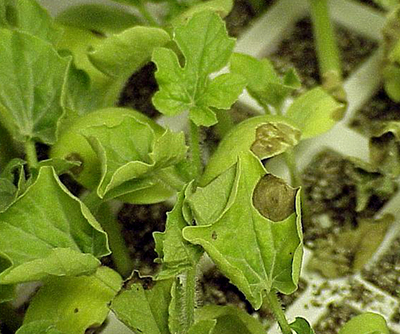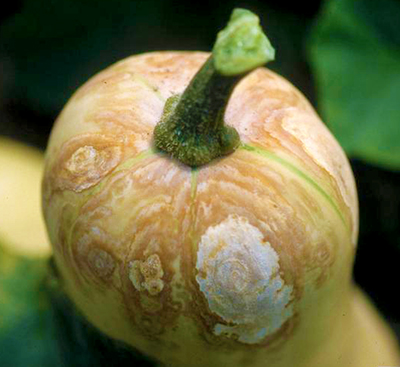Did your vine crops suffer from gummy stem blight in 2014?
Vine crop growers should follow these disease management tactics for next growing season. Growers can also learn more about managing gummy stem blight by attending the 2015 Great Lakes Expo educational sessions.

Gummy stem blight is a common disease of cucurbits worldwide, and in northern states has been prevalent on squashes and pumpkins. Gummy stem blight is caused by the fungal pathogen Didymella bryoniae. Disease development is highly influenced by humidity and free moisture on leaves caused by rain or extended dew periods. Field dispersal of the pathogen is aided by rain and wind. Wounding of the stem and fruit plays a role on initial infection and can increase disease severity.
Symptoms of gummy stem blight occur in leaves, stems, plant crowns and fruit. Circular, water-soaked lesions develop on seedlings, cotyledons, first true leaves and secondary leaves. Lesions on leaves expand and coalesce and can cause leaf blighting. Melon and watermelon foliage is more susceptible to gummy stem blight than squash and pumpkin foliage. In watermelons and muskmelons, severe foliar symptoms can result in sunburned fruit and smaller fruit size.
Symptoms on the stems start as large, water-soaked lesions that expand and form a canker (tissue turns necrotic, brown and hardens). Stem cankers and girdling can result in death of newly transplanted plants. Canker symptoms are more common in muskmelons than cucumbers, pumpkins, squash and bottle gourds. In both leaf and stem lesions, small dots known as pycnidia, or fruiting bodies of the pathogen, can be observed using a magnifying hand lens.

Gummy stem blight symptoms on watermelon seedlings. Photo credit: Jason Brock, University of Georgia, Bugwood.org
Infections in older muskmelon vines result in abundant stem cankers and ultimately can result in vine wilting. A gummy exudate is generally associated with the stem lesions, thus the name “gummy stem blight."
On fruit, symptoms start as water-soaked lesions with or without the gummy exudate on the blossom end of the fruit. Fruit lesions expand and eventually can turn the watermelon fruit black, often referred to as black rot. Black rot can occur in the field or in storage. Butternut, Hubbard, buttercup, and acorn squashes are most susceptible to fruit symptoms.

Gummy stem blight symptoms on winter squash fruit. Photo credit: Gerald Holmes, California Polytechnic State University at San Luis Obispo, Bugwood.org
Tactics to manage gummy stem blight
The pathogen that causes gummy stem blight is seedborne, therefore infection can occur as early as the seedling stage. Michigan State University Extension recommends growers plant seed that has been treated with a fungicide to decrease the risk of introducing the pathogen into clean fields. When transplants are used, it is critical to reduce the level of humidity in the greenhouse by increasing ventilation and managing irrigation. Scout transplants for the presence of symptoms and rogue diseased plants and neighboring plants, even if neighboring plants do not yet have symptoms.
Didymella bryoniae can survive in the soil or on infected plant debris. In fields where gummy stem blight was present, avoid planting cucurbit crops for two years and rotate with other non-cucurbit crops, such as Poaceae - grains, Solanaceae - tomato, Brassicaceae - cabbage families.
No resistant varieties for gummy stem blight are available for muskmelons, cucumbers or winter squash. The watermelon varieties ‘Compadre’ and ‘Dark Star’ and the honeydew varieties ‘Passport’ and ‘Tweety’ are listed as having moderate resistance to gummy stem blight, but no data is available for the performance of these varieties in Michigan.
In studies conducted in Delaware, a spring-killed hairy vetch reduced the severity of gummy stem blight by 43 percent. However, on a very humid year with high gummy stem blight pressure, the percentage gummy stem blight reduction on the hairy vetch plots was not significant. This cover crop has also shown some degree of suppression of Fusarium wilt in watermelon, and growers with gummy stem blight and Fusarium wilt problems in the field are encouraged to explore this alternative.
Multiple fungicides are labeled to manage gummy stem blight in melons. A combination of the plasticity of the pathogen (D. bryoniae) and the repeated use of highly effective single-site systemic fungicides has resulted in fungicide resistance issues in production areas in the South.
Choosing a fungicide program
Understanding FRAC groups in fungicides labels is critical to delay resistance issues. The Fungicide Resistance Action Committee (FRAC) developed numerical groups to help you identify products that attack fungi in different ways. For example, the QoI fungicides (quinone outside inhibitors), also known as strobilurins, disrupt fungal respiration and are grouped in FRAC 11. The table below lists fungicides labeled in melons and squash to manage gummy stem blight.
Fungicides labeled in melons and squash that manage gummy stem blight
|
FRAC GROUP |
Active ingredient |
Trade name |
Resistance risk |
|
1 |
Thiophanate-Methyl |
Topsin products |
High |
|
3 |
Tebuconazole |
Folicur |
Medium |
|
3+9 |
Difenoconazole+ Cyprodinil |
Inspire super |
|
|
7 |
Boscalid |
Endura |
High |
|
7 |
Penthiopyrad |
Fontelis |
|
|
M3 |
Mancozeb |
Manzate products |
Low |
|
M5 |
Chlorothalonil |
Bravo products |
|
|
M1 |
Copper (hydroxide, oxychloride, sulfate etc.) |
Copper products |
|
|
11 |
Pyraclostrobin |
Cabrio |
High |
|
11 |
Azoxystrobin |
Quadris |
|
|
Premixed with strobilurin (11) |
|||
|
11+M5 |
Azoxystrobin/Chlorothalonil |
Quadris Opti |
Medium to high |
|
11+3 |
Azoxystrobin/Difenoconazole |
QuadrisTop |
|
|
11+7 |
Pyraclostrobin+Bosclid |
Pristine |
|
Resistance of D. bryoniae has been reported for products in FRAC groups 1, 11 and 7 (benzimidazole, QoI and SDHI fungicides respectively) in southern states. Products that belong in these FRAC groups were initially very effective for managing gummy stem blight, but resistance was documented a few years after their introduction into spray programs. Currently, there are no reports of fungicides in FRAC group 11 failing to control gummy stem blight in Michigan. However, due to the high risk of resistance development in FRAC group 11, it is essential that producers alternate between fungicides from different FRAC groups to avoid the build-up of resistance.
Notice that some products on the table are premixed and, therefore, have two FRAC groups. Planning your fungicide rotation based on FRAC codes instead of active ingredients ensures that you are truly alternating to new modes of action with each application and can help delay or prevent resistance development.
Melons and watermelons tend to become susceptible to gummy stem blight sooner than cucumbers and squash with sprays recommended as early as the flowering stage. Cucumbers and squash become more susceptible as plants age, therefore sprays should focus on adult plants.
Vine crops growers have the opportunity to learn from current and ongoing research to manage gummy stem blight by attending the vine crops educational session at the 2015 Great Lakes Fruit, Vegetable and Farm Market Expo on Dec. 9. Pre-register by Nov. 20 to save money and time.
For more information
- Diagnostic Guide for Gummy Stem Blight and Black Rot on Cucurbits from Plant Management Network
- Integrated Management of Gummy Stem Blight of Watermelon by Green Manure and Melcast-scheduled Fungicides from Plant Management Network
- Boscalid Insensitivity Documented in Didymella bryoniae Isolated from Watermelon in Florida and North Carolina from Plant Management Network
- Gummy Stem Blight from American Phytopathological Society (APS)
- Vegetable MD Online: Gummy Stem Blight from Cornell University
- Keep gummy stem blight out of your watermelons from North Carolina State University
- Gummy Stem Blight of Cucurbits from North Carolina State University



 Print
Print Email
Email




